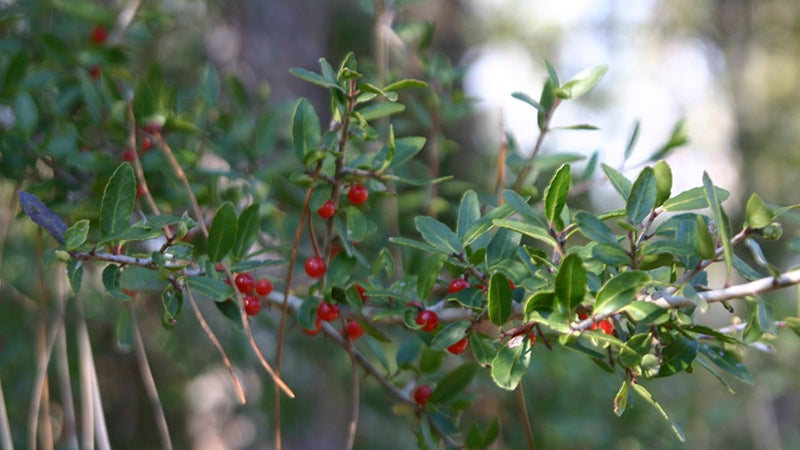Native plants that shine in fall and winter
Published 7:00 am Wednesday, November 28, 2018

- Yaupon holly is commonly found in woodland edges, thickets and fencelines, where it provides food and cover for wildlife. Photo by Pat Drackett
By Patricia R. Drackett, Director and Assistant Extension Professor of Landscape Architecture
The Crosby Arboretum, Mississippi State University Extension Service
Lately, some of the trees and shrubs in our local landscape are positively glowing! Rusty-leaved bald cypress line the edge of the Arboretum’s Piney Woods pond, and the roads are dotted with gold, crimson, and burgundy from maple, oak, and sumac trees.
These native trees let us know that autumn has arrived, and winter will soon be on its way. Other trees that make attractive additions to the landscape due to their attractive fall color include sweetgum, black gum, and swamp chestnut oak.
One exceptional native shrub that is hard to ignore in the fall and winter is Elliott’s blueberry (Vaccinium elliottii). Its leaves are turning a gorgeous scarlet red, which makes it easy to spot from your car window on a county ride.
This blueberry – also called a “huckleberry” – can often be found growing at the base of utility poles or mingled among the roots of a mature tree, where it escapes mowing once it has been “planted” by perching birds that have feasted on its fruits. Elliott’s blueberry makes a great addition to your wildlife garden, and humans also relish its small, sweet berries in the springtime. These make an excellent topping for cereal or pancakes, or perhaps inspire you to cook up a batch of homemade jam.
A large specimen of Elliot’s blueberry is growing on the Arboretum’s loop drive. The mature shrub has a graceful, open form, and towers over our heads and parked cars. In your yard, it will lend its beauty to a mixed hedge or even as a specimen. After a show of rich autumn hues, the leaves will fall to reveal the structure of this plant and the surprising green coloration of the delicate branches. One of the first plants to bloom, as early as January, it will beckon to passing bees.
Elliott’s blueberry produces its best fruit in full sun but also bears in light shade. It will survive dense shade. The shrub thrives in poorly drained wet soil as well as in well-drained sandy soil. When established, it will tolerate normal droughts.
The Arboretum has many species of holly, including deciduous holly (Ilex decidua), yaupon (Ilex vomitoria), gallberry (Ilex glabra), and American holly (Ilex opaca). Hollies are excellent choices for both the home landscape and the wildlife garden. Their flowers are particularly attractive to bees, and their fruit is consumed by birds and other animals.
American holly’s sharp spines give it an appearance similar to that of traditional English holly. Several multi-trunked specimens are located outside the Crosby Arboretum Visitor Center, where the deck has been cut out to accommodate them.
On a walk down the east side of the Pond Journey, you’ll discover several American hollies leaning over at an angle, having been blown over in Hurricane Katrina. They have taken this rearrangement in stride, and some years will put on an incredible show of bright red berries.
Use American holly in your landscape as a single specimen or groupings, or in plantings along your property line to provide screening. Although this evergreen tree can grow up to 40 or 50 feet tall, it is slow to attain these heights. The tree makes a good choice for your landscape due to its usefulness in being pruned for holiday greens to decorate your home. The clippings are elegant in a brass or crystal bowl on the dining room table, or strewn on the fireplace mantle.
Why not plant a few new trees in your yard this winter? The upcoming winter dormant season offers a perfect time for planting, as roots will have time to become established before the return of hot weather.
A children’s craft workshop on Biodegradable Bird Feeders takes place on Saturday, December from 10:00 to 11:00 a.m. Children will enjoy watching the birds and squirrels that will be attracted to your yard after they create several different types of bird feeders fashioned from biodegradable items. There is no age limit, as an adult must be present to assist children. Cost: Arboretum members $4 per child, and non-members $6 per child (no charge for adults). Reservations requested. Please call 601-799-2311 or email kim.johnson@msstate.edu<mailto
See www.crosbyarboretum.msstate.ed




